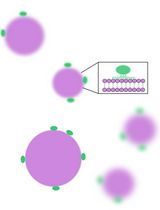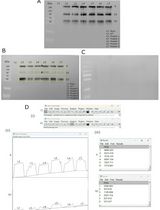- Submit a Protocol
- Receive Our Alerts
- Log in
- /
- Sign up
- My Bio Page
- Edit My Profile
- Change Password
- Log Out
- EN
- EN - English
- CN - 中文
- Protocols
- Articles and Issues
- For Authors
- About
- Become a Reviewer
- EN - English
- CN - 中文
- Home
- Protocols
- Articles and Issues
- For Authors
- About
- Become a Reviewer
Radioactive Pulse-Chase Analysis and Immunoprecipitation
Published: Vol 4, Iss 8, Apr 20, 2014 DOI: 10.21769/BioProtoc.1101 Views: 12861
Reviewed by: Anonymous reviewer(s)

Protocol Collections
Comprehensive collections of detailed, peer-reviewed protocols focusing on specific topics
Related protocols

Radioactive Assay of in vitro Glutamylation Activity of the Legionella pneumophila Effector Protein SidJ
Alan G. Sulpizio [...] Yuxin Mao
Oct 5, 2020 3545 Views

Flotation Assay With Fluorescence Readout to Study Membrane Association of the Enteroviral Peripheral Membrane Protein 2C
Kasturika Shankar [...] Lars-Anders Carlson
Apr 5, 2025 1194 Views

Detection and Analysis of S-Acylated Proteins via Acyl Resin–Assisted Capture (Acyl-RAC)
Dina A. Abdulrahman and Michael Veit
Apr 5, 2025 1364 Views
Abstract
Labeling of newly-synthesized polypeptides with radioactive amino acids followed by immunoprecipitation allows quantitative analysis of the fate of a given protein in a time-dependent manner. This biochemical approach is usually used to study a variety of processes, such as protein folding, co-translational modifications, intracellular transport, and even its rate of degradation. Here, I describe step by step a simple technique to both label newly-synthesized influenza A virus (IAV) hemagglutinin (HA) with [35S]-methionine and then follow its maturation and transport through the secretory pathway by SDS-PAGE and fluorography (Magadan et al., 2013).
Materials and Reagents
- ~5 x 106 MDCK cells (ATCC, catalog number: CCL-34 )
- 0.05% 1x Trypsin-EDTA (phenol red) (Life Technologies, catalog number: 25300054 )
- DPBS (Life Technologies, catalog number: 14190-250 )
- Anti-HA antibodies (mostly home-made)
- nProtein A Sepharose 4 Fast Flow (GE, catalog number: 17-5280-02 )
- 4x NuPAGE LDS sample buffer (Life Technologies, catalog number: NP0007 )
- NuPAGE Novex 4-12% Bis-Tris protein gels (Life Technologies, catalog number: NP0321PK2 )
- NuPAGE MES SDS running buffer (Life Technologies, catalog number: NP000202 )
- DMEM media without methionine and cysteine (Life Technologies, catalog number: 21013024 )
- EDTA-free protease inhibitor cocktail (Roche Diagnostics, catalog number: 04693159001 )
- 10% Triton X-100 surfact-amps detergent solution (Thermo Fisher Scientific, catalog number: 28314 )
- UltraPure 1 M Tris-HCI Buffer (pH 7.5) (Life Technologies, catalog number: 15567-027 )
- UltraPure 5 M NaCl (Life Technologies, catalog number: 24740-011 )
- UltraPure 0.5 M EDTA (pH 8.0) (Life Technologies, catalog number: 15575-020 )
- Methanol (Sigma-Aldrich, catalog number: 322415 )
- Acetic acid (Sigma-Aldrich, catalog number: 320099 )
- DMEM media (Life Technologies, catalog number: 10569-010 )
- DMEM media with 7.5% fetal bovine serum (see Recipes)
- Pulse medium (see Recipes)
- Chase medium (see Recipes)
- Non-denaturing lysis buffer (see Recipes)
- Fixation solution (see Recipes)
- L-cysteine (Sigma-Aldrich, catalog number: W326305 ) (see Recipes)
- [35S]-methionine (PerkinElmer, catalog number: NEG-709-A005MC ) (see Recipes)
- L-methionine (Sigma-Aldrich, catalog number: M9625 ) (see Recipes)
Equipment
Note: Designated for working with radioactive materials.
- Appropriate containers to dispose liquid and solid [35S]-waste following local radiation safety guidelines
- T-75 tissue culture flask (Thermo Fisher Scientific)
- 50 ml BD Falcon tube (BD Biosciences, Falcon®)
- A water bath set at 37 °C
- A refrigerated micro-centrifuge
- A rotator for 1.5 ml micro-centrifuge tubes settled at 4 °C
- 1.5 ml micro-centrifuge tubes
- A chamber to run mini-gels [I routinely use the XCell SureLock Mini Cell electrophoresis system (Life Technologies, catalog number: EI0001 ).]
- Carestream Kodak BioMax MR films (Sigma-Aldrich, catalog number: Z350400 )
- Kodak X-OMAT 2000A processor
- A gel-dryer
- A cassette for autoradiography
Procedure
- Radioactive Pulse-Chase
- Detach MDCK cells [grown in a T-75 tissue culture flask and infected with 10 infectious doses of influenza A/Puerto Rico/8/34 (PR8) virus per cell for 5 h at 37 °C (Magadan et al., 2013)] by incubating them with 5 ml Trypsin-EDTA for ~15 min at 37 °C.
- Transfer cells to a 50 ml BD Falcon tube and wash them twice with 10 ml pre-warmed DPBS by centrifugation for 1 min at 2,500 x g, room temperature.
- Resuspend cells in 1 ml DPBS and transfer them to a 1.5 ml micro-centrifuge tube.
- Centrifuge cells for 15 sec at max speed, 4 °C.
- Resuspend cells in 200 µl of pre-warmed pulse medium.
- Incubate cells for 2 min at 37 °C in a water bath (pulse).
- Centrifuge cells for 15 sec at max speed, 4 °C.
- Aspirate the supernatant and resuspend the cell pellet in 1.05 ml of pre-warmed chase medium.
- Incubate labeled cells for up to 20 min at 37 °C in a water bath.
- Take aliquots of 190 µl each at 0, 5, 10, 15, and 20 min and immediately transfer them to new 1.5 ml micro-centrifuge tubes containing 1 ml of ice-cold DPBS.
- Centrifuge cells for 15 sec at max speed, 4 °C.
- Aspirate the supernatant and resuspend the cell pellet in 1 ml ice-cold non-denaturing lysis buffer.
- Incubate cell lysates for 30 min at 4 °C with slow rotation.
- Clear cell lysates by centrifugation for 15 min at max speed, 4 °C.
- Keep the supernatant but discard the pellet.
- Detach MDCK cells [grown in a T-75 tissue culture flask and infected with 10 infectious doses of influenza A/Puerto Rico/8/34 (PR8) virus per cell for 5 h at 37 °C (Magadan et al., 2013)] by incubating them with 5 ml Trypsin-EDTA for ~15 min at 37 °C.
- Immunoprecipitation
- Wash 30 µl of protein A sepharose/each chase-time point twice with 0.5 ml of ice-cold DPBS by centrifugation for 1 min at 3,000 x g, 4 °C.
- Resuspend resin in 0.5 ml of ice-cold DPBS supplemented with 0.001% Triton X-100 and the anti-HA antibody of choice.
- Incubate for at least 2 h at 4 °C with slow rotation.
- Wash resin twice with 0.5 ml of ice-cold non-denaturing lysis buffer (without protease inhibitors).
- Add 10 µl 10% BSA.
- Add the cleared cell lysate from each chase-time point.
- Incubate for at least 2 h at 4 °C with slow rotation.
- Wash resin twice with 0.5 ml of ice-cold non-denaturing lysis buffer (without protease inhibitors) but containing 0.1% instead of 0.5% Triton X-100.
- Wash resin once with 0.5 ml of ice-cold DPBS.
- Resuspend resin in 20 µl of 4x LDS sample buffer.
- Boil samples for 5 min.
- Wash 30 µl of protein A sepharose/each chase-time point twice with 0.5 ml of ice-cold DPBS by centrifugation for 1 min at 3,000 x g, 4 °C.
- SDS-PAGE and Fluorography
- Load 15 µl of every sample onto protein mini-gels.
- Run for ~3 h at constant 50 mA/gel.
- Fix gels with 10 ml fixation solution for at least 30 min at room temperature with slow rocking.
- Dry gels in a gel drier for 1.5 h at 80 °C (in the case of 1 mm gels).
- Expose films to the radioactive gels overnight at room temperature.
- I usually develop my films using a Kodak X-OMAT 2000A processor.
- Please refer to Figure 1 on our prior publication (Magadan et al., 2013) for representative results and conclusions.
- Load 15 µl of every sample onto protein mini-gels.
Recipes
- DMEM media with 7.5% fetal bovine serum
Supplement DMEM media with 7.5% fetal bovine serum by adding ~40 ml commercial stock to 500 ml liquid media
- Pulse medium
DMEM media without methionine and cysteine supplemented with 0.20 mM L-cysteine and 0.2 mCi/ml [35S]-methionine
- Chase medium
DMEM media supplemented with 7.5% fetal bovine serum and 67 mM L-methionine
- Non-denaturing lysis buffer
0.5% Triton X-100
50 mM Tris-HCl (pH 7.5)
300 mM NaCl
5 mM EDTA
Complete mini, EDTA-free protease inhibitor cocktail
- Fixation solution
50% methanol
10% acetic acid
- L-cysteine
Dissolve 12.116 mg commercial powder in 500 ml DMEM media without methionine and cysteine to obtain a new media supplemented with 0.20 mM L-cysteine
- [35S]-methionine
Add 19.6 µl of the 5 mCi/0.49 ml stock solution to 1 ml DMEM media without methionine to get a 0.2 mCi/ml working solution
- L-methionine
Dissolve 10 mg commercial powder in 1 ml DMEM media + 7.5% fetal bovine serum to obtain a chase media supplemented with 67 mM L-methionine
Acknowledgments
This protocol has been adapted from a previously published paper (Magadan et al., 2013). This work was supported by the Division of Intramural Research of the National Institute of Allergy and Infectious Diseases, National Institutes of Health.
References
- Magadan, J. G., Khurana, S., Das, S. R., Frank, G. M., Stevens, J., Golding, H., Bennink, J. R. and Yewdell, J. W. (2013). Influenza A virus hemagglutinin trimerization completes monomer folding and antigenicity. J Virol 87(17): 9742-9753.
Article Information
Copyright
© 2014 The Authors; exclusive licensee Bio-protocol LLC.
How to cite
Magadán, J. G. (2014). Radioactive Pulse-Chase Analysis and Immunoprecipitation. Bio-protocol 4(8): e1101. DOI: 10.21769/BioProtoc.1101.
Category
Microbiology > Microbial biochemistry > Protein > Labeling
Biochemistry > Protein > Immunodetection
Do you have any questions about this protocol?
Post your question to gather feedback from the community. We will also invite the authors of this article to respond.
Tips for asking effective questions
+ Description
Write a detailed description. Include all information that will help others answer your question including experimental processes, conditions, and relevant images.
Share
Bluesky
X
Copy link









